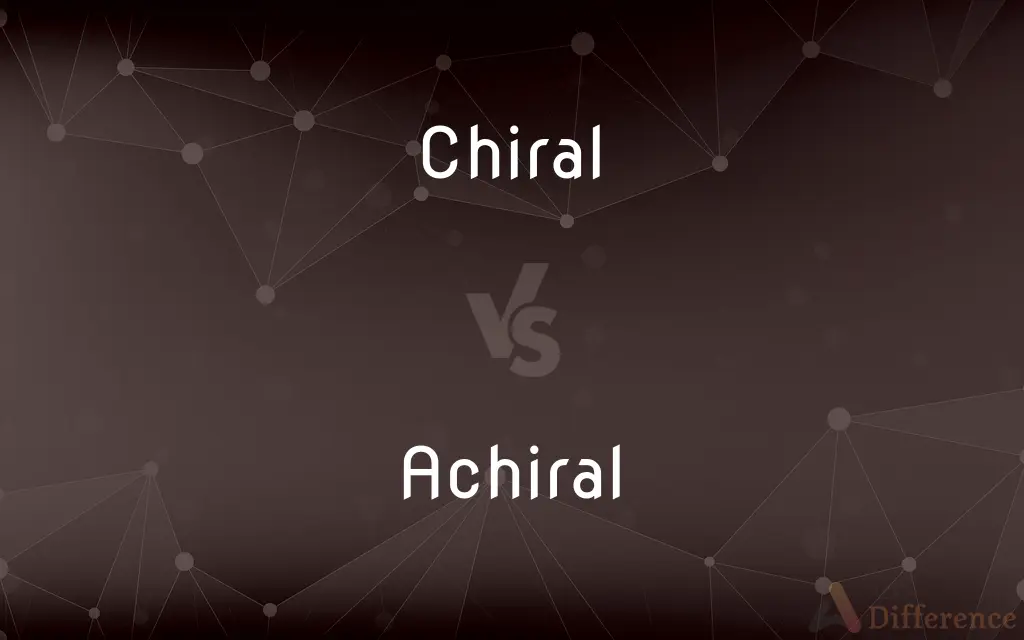Chiral vs. Achiral — What's the Difference?
By Tayyaba Rehman — Updated on September 21, 2023
A chiral molecule lacks an identical mirror image, while an achiral molecule has a superimposable mirror image. Both terms describe molecular symmetry in chemistry.

Difference Between Chiral and Achiral
Table of Contents
ADVERTISEMENT
Key Differences
Chiral and achiral are terms rooted in stereochemistry, a branch of chemistry concerned with the spatial arrangement of atoms. Chiral molecules have a unique characteristic: they cannot be superimposed onto their mirror image, much like a person's left and right hands.
Achiral molecules, in contrast, possess a mirror image that can be superimposed onto the original molecule. In simpler terms, an achiral molecule has a symmetry that allows its mirror image to perfectly overlap with its original structure.
Chiral molecules often contain a carbon atom bonded to four different groups, known as a chiral center or stereocenter. The presence of a chiral center ensures that the molecule exists in two non-superimposable forms, termed enantiomers. Each enantiomer can rotate plane-polarized light in opposite directions.
On the other hand, achiral molecules either lack a chiral center altogether or have chiral centers but possess an internal plane of symmetry. This symmetry ensures that even if chiral centers are present, the molecule's overall structure remains superimposable with its mirror image.
The distinction between chiral and achiral is crucial in pharmaceuticals, as different enantiomers of a chiral drug can exhibit varied biological activities, while achiral compounds exhibit consistent properties regardless of their orientation.
ADVERTISEMENT
Comparison Chart
Mirror Image
Non-superimposable.
Superimposable.
Presence of Symmetry
Lacks a plane of symmetry.
Has a plane of symmetry.
Chiral Centers
Contains chiral centers.
May lack or have chiral centers with symmetry.
Rotation of Light
Can rotate plane-polarized light (optically active).
Doesn't rotate plane-polarized light.
Biological Activity
Enantiomers can have different activities.
Consistent activity regardless of orientation.
Compare with Definitions
Chiral
Pertaining to a molecule with a non-superimposable mirror image.
Many drugs are chiral, leading to different effects based on their orientation.
Achiral
Relating to molecules that don't rotate plane-polarized light.
Achiral substances are optically inactive, having no effect on the plane of polarization.
Chiral
A molecule that cannot be superimposed on its mirror image.
The amino acid L-alanine is chiral due to its specific spatial arrangement.
Achiral
A molecule that can be superimposed on its mirror image.
Methane is achiral, as its mirror image is identical to its original form.
Chiral
A descriptor for molecules lacking a plane of symmetry.
The molecule's chiral center gives it unique optical properties.
Achiral
Pertaining to a molecule lacking chiral centers or having symmetric chiral centers.
Despite having two chiral centers, meso-tartaric acid is achiral due to its symmetry.
Chiral
Concerning molecules that can rotate plane-polarized light.
Chiral molecules are of interest in optical studies due to their ability to affect light's plane of polarization.
Achiral
A descriptor for molecules possessing a plane of symmetry.
Achiral compounds often exhibit consistent properties in various orientations.
Chiral
Relating to the presence of chiral centers in a molecule.
A molecule with multiple chiral centers can have various stereoisomers.
Achiral
Concerning compounds without enantiomers.
Achiral compounds do not have mirror-image forms with different properties.
Chiral
Relating to or exhibiting chirality.
Achiral
Superimposable on its mirror image; amphichiral
Chiral
That exhibits chirality (as in the left-handed and right-handed versions of a helix)
Common Curiosities
What makes a molecule chiral?
A molecule is chiral if it cannot be superimposed on its mirror image, often due to a chiral center.
Can an achiral molecule rotate plane-polarized light?
No, achiral molecules are optically inactive and don't rotate plane-polarized light.
Are all chiral molecules optically active?
Yes, chiral molecules can rotate plane-polarized light and are thus optically active.
Share Your Discovery

Previous Comparison
Gabber vs. Hardstyle
Next Comparison
Bake vs. BroilAuthor Spotlight
Written by
Tayyaba RehmanTayyaba Rehman is a distinguished writer, currently serving as a primary contributor to askdifference.com. As a researcher in semantics and etymology, Tayyaba's passion for the complexity of languages and their distinctions has found a perfect home on the platform. Tayyaba delves into the intricacies of language, distinguishing between commonly confused words and phrases, thereby providing clarity for readers worldwide.













































